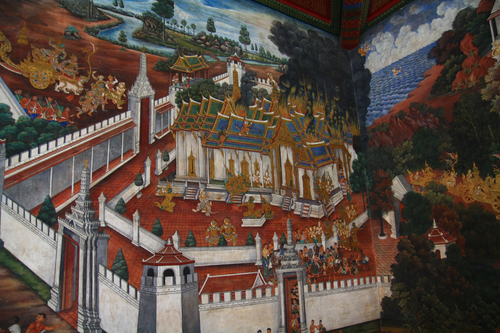ค้นหางานศิลปกรรม
ฐานข้อมูลศิลปกรรมในเอเชียตะวันออกเฉียงใต้
จิตรกรรมจิตรกรรมฝาผนังเรื่องรามเกียรติ์
จิตรกรรมแบบไทยประเพณีผสมผสานกับเทคนิคการเขียนภาพแบบสมัยใหม่ ลักษณะที่แสดงถึงความเป็นจิตรกรรมไทยแบบประเพณี ได้แก่ ภาพบุคคลในเรื่องที่เป็นตัวละคนสำคัญแต่งกายยืนเครื่องเช่นเดียวกับการแต่งกายในการแสดงโขน กิริยาอาการอยู่ในท่านาฏลักษณ์ มีการปิดทองคำเปลวที่เครื่องทรงของตัวละครที่สำคัญ เป็นต้น ส่วนเทคนิคการเขียนภาพแบบใหม่ที่แตกต่างจากจิตรกรรมไทยประเพณี ได้แก่ การกำหนดเส้นขอบฟ้าและวางระยะของวัตถุในภาพทำให้เกิดมิติ การเขียนภาพเหมือนของอาคารสถานที่ที่มีอยู่จริง เช่น พระมหาปราสาทในพระบรมมหาราชวัง และการเขียนภาพทิวทัศน์ต่างๆ อย่างเหมือนจริง นอกจากนี้ ยังมีการสอดแทรกเรื่องราววิถีชีวิตชาววัง ชาวบ้าน และอารมณ์ขันต่างๆ ผ่านตัวละครประกอบของเรื่อง จิตรกรรมฝาผนังมีทั้งสิ้น 178 ห้องภาพ ใต้ภาพมีโคลงเรื่องรามเกียรติ์ประกอบ รวมทั้งสิ้น 224 บท
ประติมากรรมหน้าบันสลักภาพเล่าเรื่องรามเกียรติ์ ตอน โมกขศักดิ์
หน้าบันมีลักษณะยืดสูงเป็นทรงสามเหลี่ยม มีกรอบซุ้มเป็นซุ้มคดโค้ง กล่าวคือมีการทำกรอบโค้งเข้าโค้งออกอย่างสวยงาม ปลายกรอบซุ้มเป็นรูปนาคหลายเศียรตามแบบหน้าบันในสมัยพระนครตอนปลาย ตรงกลางหน้าบันปรากฏภาพสลักเล่าเรื่องรามเกียรติ์ ตอน โมกขศักดิ์


